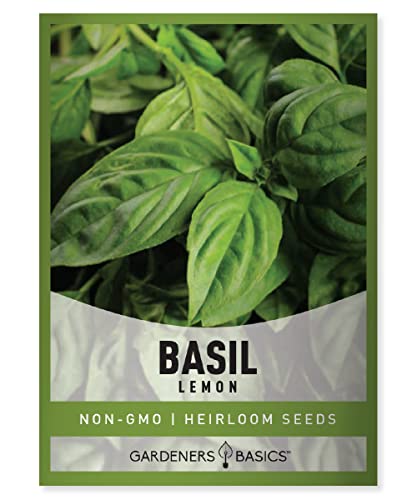What is Lemon Basil?
Are you tired of cooking the same old meals and looking for a way to elevate your dishes? Look no further than lemon basil! This versatile herb not only adds a burst of refreshing citrus flavor to your recipes but also brings a delightful aroma to your kitchen. It is also known as Thai lemon basil or Lao basil, and is a popular ingredient in Southeast Asian cuisine which has gained popularity in Western cooking as well. Its bright and zesty flavor profile makes it a perfect addition to salads, marinades, soups, stir-fries, and even cocktails. Not only does it enhance the overall taste of your dishes, but it also offers numerous health benefits. Packed with antioxidants, vitamins, and minerals, this herb can boost your immune system, aid digestion, and promote healthy skin.
So, why not take your culinary creations to new heights with the vibrant and aromatic lemon basil? Let’s dive into the world of this incredible herb and unlock a whole new level of flavor in your kitchen!
History & Background
Lemon basil, also known as Thai lemon basil or Lao basil, has a rich history that dates back centuries. In ancient Greece, basil was considered a sacred plant associated with various rituals and beliefs. It was often dedicated to deities such as Apollo and used in religious ceremonies, including funerals. Basil was believed to possess protective qualities and was used to ward off evil spirits. It was also used in wreaths and garlands placed on tombs and graves as a symbol of remembrance.
While there is no direct mention of lemon basil specifically being used in mourning rituals in ancient Greece, it is possible that it may have been included in funeral practices as a fragrant herb or for its symbolic significance. However, without specific historical records, it is difficult to make definitive statements about its use.
Cultivated in Southeast Asia, it has been a staple in the region’s cuisine for generations. The herb gets its name from its distinct lemon-like fragrance and taste, which sets it apart from other varieties of basil.
Lemon basil is believed to have been brought to Europe in the 17th century by explorers and traders. Since then, it has gained popularity in Western cooking as well. Today, it can be found in both traditional Asian dishes and contemporary fusion recipes.
What form does it come in?
Lemon basil is available in various forms to suit different culinary needs. The most common form is fresh leaves, which can be easily found in supermarkets and farmers’ markets. These vibrant green leaves are packed with flavor and aroma, making them perfect for garnishing dishes or adding a punch of citrus to recipes.
Dried lemon basil is another option for those who want to enjoy the herb year-round. It can be found in specialty stores and is a convenient choice for those who prefer to keep a stock of herbs in their pantry. While dried lemon basil may not have the same intensity as fresh leaves, it still adds a delightful lemony flavor to your dishes.
Did you know that you can also grow your own lemon basil? It has similar growing requirements to other basil varieties and can be grown in gardens, containers, or even indoors.
We have included a link for Lemon Basil seeds, so you can grow your own.
Lemon Basil Seeds – grow your own lemon basil – always have a fresh supply.
It is known for its ability to produce abundant leaves, especially if you practice regular harvesting. As you harvest the leaves, the plant will continue to grow new foliage, providing you with a steady supply of fresh herbs.
Open-pollinated, Non-GMO, Heirloom heritage.
300mg of seeds – product of the USA.
How to grow your own
To grow your own lemon basil, you can follow these steps:
- It thrives in full sunlight, so select a sunny spot in your garden or a location with at least 6-8 hours of direct sunlight each day.
- It prefers well-drained soil that is rich in organic matter. Amend the soil with compost or well-rotted manure to improve its fertility and drainage.
- You can start lemon basil from seeds or purchase seedlings from a local nursery. If starting from seeds, sow them directly into the prepared soil after the last frost date in your area. Plant the seeds about ¼ inch deep and cover them lightly with soil. Space the seeds or seedlings about 6-12 inches apart.
- Keep the soil consistently moist, but not waterlogged. Water the plants regularly, particularly during dry spells. Be careful not to overwater, as excessive moisture can lead to root rot.
- It benefits from regular feeding. Apply a balanced organic fertilizer every 4-6 weeks, following the package instructions for application rates. Alternatively, you can use compost or well-rotted manure to provide nutrients to the plants.
- To encourage bushier growth and prevent the plant from becoming leggy, pinch off the tips of the stems regularly. This will also encourage the plant to produce more flavorful leaves.
- Once the plants reach a height of about 6-8 inches, you can start harvesting the leaves. Snip off the outer leaves or cut the stems just above a pair of leaves. Regular harvesting will encourage new growth and ensure a continuous supply of fresh leaves.
- Keep an eye out for common basil pests like aphids, whiteflies, and spider mites. If you notice any infestations, you can try using organic pest control methods such as insecticidal soap or neem oil. Proper air circulation and avoiding excessive moisture can help prevent fungal diseases.
By following these steps, you can successfully grow lemon basil and enjoy its aromatic leaves in various culinary applications.
- Sunlight requirements: It thrives in full sunlight, making it suitable for outdoor spaces with ample sunlight. It requires at least 6-8 hours of direct sunlight per day.
- Soil preferences: It prefers well-drained soil that is rich in organic matter. As long as you provide well-prepared soil or use a quality potting mix, it should grow well.
- Watering needs: It requires regular watering to keep the soil moist but not waterlogged. It’s important to find a balance and avoid overwatering, as excessive moisture can lead to root rot.
- Quick germination: The seeds typically germinate within 7-14 days, making it a relatively quick-growing herb. This means you can see progress and enjoy fresh leaves within a few weeks of planting.
- Versatility: It can be grown in various settings, including gardens, raised beds, containers, or even on windowsills. Its compact size also makes it suitable for smaller spaces.
- Few pest and disease problems: While basil can be susceptible to pests like aphids and diseases like fungal infections, lemon basil is generally resilient. With proper care and monitoring, you can prevent most pest and disease issues.
- Continuous harvest: It is known for its ability to produce abundant leaves, especially if you practice regular harvesting. As you harvest the leaves, the plant will continue to grow new foliage, providing you with a steady supply of fresh herbs.
Of course, successful growth depends on various factors such as climate, soil conditions, and care. However, overall, it is considered relatively easy to grow, making it a great choice for gardeners of different experience levels.
Is lemon basil good for you?
In addition to its culinary benefits, it also offers numerous health benefits. Packed with antioxidants, vitamins, and minerals, this herb can boost your immune system, aid digestion, and promote healthy skin.
It is a great source of vitamin C, which is essential for a healthy immune system. It also contains vitamin A, which is important for maintaining good vision and healthy skin. The herb is rich in antioxidants, which help protect your body against free radicals and reduce the risk of chronic diseases.
Furthermore, lemon basil has antibacterial and anti-inflammatory properties, making it a natural remedy for various ailments. It can help soothe an upset stomach, relieve indigestion, and reduce inflammation in the body. So as you can see there are many lemon basil benefits to enjoy.
Flavor profile and culinary uses
Lemon basil is known for its distinct flavor profile that combines the bright citrusy notes of lemon with the earthy and slightly spicy taste of basil. This unique combination makes it a versatile herb that can be used in a wide range of dishes.
The herb’s vibrant flavor pairs well with both savory and sweet ingredients, making it a popular choice for various recipes. Its refreshing citrus notes complement seafood dishes, such as grilled fish or shrimp scampi. It also adds a delightful twist to salads, marinades, and dressings, giving them a burst of freshness.
In addition to its savory applications, it can also be used in sweet recipes. It adds a unique and unexpected flavor to desserts like lemon basil sorbet or lemon basil pound cake. The herb can even be muddled into cocktails, adding a refreshing and aromatic element to your drinks.
Cooking with lemon basil
When cooking with lemon basil, it’s important to use it in moderation to avoid overpowering your dishes. The herb is best added towards the end of the cooking process to preserve its delicate flavor and aroma.
To release its full potential gently bruise the leaves before adding them to your recipes. This helps to release the essential oils and intensify the citrusy notes. You can do this by rolling the leaves between your hands or using a mortar and pestle.
Lemon basil can be used in a variety of ways in the kitchen. You can chop it finely and sprinkle it over salads or pasta dishes as a garnish. Alternatively, you can use whole leaves to infuse soups, stews, or sauces with its aromatic flavor.
Common uses for lemon basil
Beyond its culinary uses, lemon basil also has several non-culinary applications. The herb’s refreshing scent makes it a popular choice for aromatherapy and natural skincare products.
Lemon basil essential oil is known for its uplifting and energizing properties. It can be used in diffusers to create a fresh and invigorating atmosphere in your home. The oil can also be added to homemade soaps, lotions, or candles to harness its aromatic benefits.
Substitutes for lemon basil
If you don’t have lemon basil on hand, there are a few substitutes that can help achieve a similar flavor profile. One option is to use a combination of regular basil and lemon zest. Simply chop fresh basil leaves and mix them with grated lemon zest to infuse your dishes with a hint of citrus.
Another substitute is lemon thyme, which has a lemony flavor with a touch of earthiness. While it may not have the same intensity as lemon basil, it can still add a refreshing twist to your recipes.
Have a look at our substitutes section for ideas on what other ingredient you can use in place of lemon basil.
Conclusion
In conclusion, lemon basil is a versatile herb that can elevate your dishes with its bright citrus flavor and delightful aroma. Whether you’re adding it to a salad, marinade, soup, stir-fry, or even a cocktail, lemon basil brings a burst of freshness to your culinary creations.
Not only does lemon basil enhance the overall taste of your dishes, but it also offers numerous health benefits. Packed with antioxidants, vitamins, and minerals, this herb can boost your immune system, aid digestion, and promote healthy skin.
So, why not take your culinary creations to new heights with the vibrant and aromatic lemon basil? Add this incredible herb to your kitchen arsenal and unlock a whole new level of flavor in your cooking.

